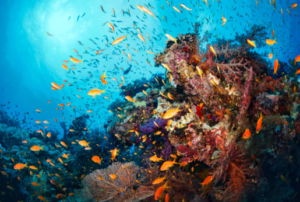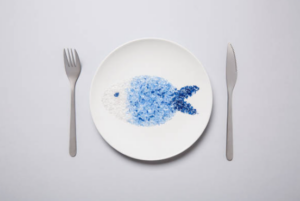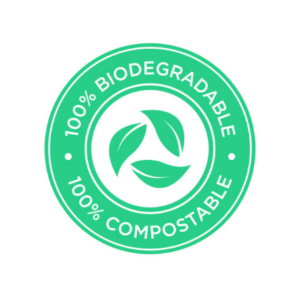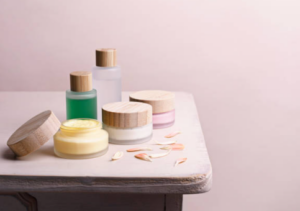How Your Skincare Routine Could Be Harming Oceans

In the quest for flawless skin and a radiant complexion, many of us invest in a variety of skincare and beauty products. We carefully choose cleansers, exfoliants, and moisturizers to enhance our skin’s health and appearance. However, there is an alarming issue lurking in our favorite beauty products that demands our attention: microplastics. These tiny plastic particles, often invisible to the naked eye, are quietly accumulating in our oceans, causing harm to marine life and potentially affecting our ecosystem. In this comprehensive guide, we will delve into the world of microplastics, their presence in beauty products, and how we can make more sustainable choices to protect our planet while still enjoying effective skincare.
Microplastics are minuscule plastic particles measuring less than 5mm in diameter. They can be categorized into two main groups:
-
- Primary Microplastics:
- Intentional Manufacture: Primary microplastics are deliberately created for specific purposes and incorporated into various consumer products, including personal care items.
- Examples: Some common examples of primary microplastics in personal care products include microbeads, microspheres, and glitter.
- Specific Functions: These microplastics are designed to serve particular functions within the product, such as exfoliation, texture enhancement, or coloration.
- Secondary Microplastics:
- Derived from Larger Plastics: Secondary microplastics are not intentionally produced but instead result from the breakdown of larger plastic items. Over time, weathering, UV exposure, and physical forces cause large plastics to fragment into smaller pieces, including microplastics.
- Sources: Larger plastic items like water bottles, bags, fishing nets, and other plastic debris in the environment eventually degrade into secondary microplastics.
- Invisible Threat: These tiny particles can be challenging to detect as they become dispersed in the environment, contributing to the overall plastic pollution problem.
Primary microplastics are of particular concern when it comes to personal care products because they are intentionally added to the formulation. These particles, though small, can have a significant cumulative effect on the environment, especially in bodies of water like oceans and rivers, where they can readily accumulate and cause harm to aquatic ecosystems.
The use of primary microplastics in beauty and skincare products, such as exfoliating scrubs and cosmetics, has been a major driver of microplastic pollution in our waterways. These tiny particles may seem harmless in isolation, but their widespread use, combined with their environmental persistence and potential harm, has raised serious concerns about their impact on marine life and the health of our oceans.
Microplastics in Beauty Products
One of the primary sources of microplastic pollution is personal care products, including skincare, cosmetics, and toiletries. Manufacturers use microplastics in these products for various purposes:
- Exfoliation: Microbeads, small plastic particles, are often added to exfoliating scrubs, body washes, and facial cleansers to help remove dead skin cells. However, when washed down the drain, these microbeads end up in our water systems.
- Texture: Some products contain microplastics to enhance their texture and feel. These can include lotions, creams, and makeup.
- Binding Agents: Microplastics are used as binding agents in certain cosmetics and skincare items, helping ingredients adhere to the skin.
The presence of microplastics in beauty products is not a benign issue. The environmental consequences are concerning:
- Marine Pollution:
- Ingestion by Marine Life: When microplastics are released into water bodies, they become accessible to marine life. Small marine organisms, such as zooplankton, filter feeders, and various fish species, often mistake these minuscule particles for food.
- Bioaccumulation: As microplastics move up the food chain, predators consume prey containing microplastics, leading to the bioaccumulation of these particles in the bodies of larger marine animals. This bioaccumulation can result in malnutrition and other health issues for these animals.
- Toxic Chemicals:
- Carriers for Toxins: Microplastics have a unique ability to adsorb and carry toxic chemicals from the surrounding environment. As they travel through the aquatic ecosystem, they may absorb pollutants like polychlorinated biphenyls (PCBs) and polycyclic aromatic hydrocarbons (PAHs).
- Bioavailability: When marine organisms ingest microplastics containing these toxic chemicals, they can release the absorbed contaminants, which may then enter the organisms’ tissues, potentially posing health risks to those who consume seafood.
- Environmental Persistence:
- Indestructible Nature: One of the most concerning aspects of microplastics is their nearly indestructible nature. Unlike organic materials, microplastics do not biodegrade; they simply break down into smaller and smaller pieces.
- Long-Term Consequences: This persistence in the environment means that microplastics continue to accumulate in our water bodies, presenting long-term threats to aquatic life and ecosystems.
- Ecosystem Disruption:
- Impact on Biodiversity: The ingestion of microplastics by marine organisms can disrupt their digestion, energy balance, and overall health. This, in turn, can have cascading effects on marine ecosystems, potentially leading to imbalances in biodiversity and ecosystem dynamics.
- Physical Damage: Microplastics, particularly those with abrasive properties like microbeads, can physically damage marine organisms’ delicate tissues, causing harm and potential injury.
- Potential Human Health Risks:
- Indirect Exposure: As humans consume seafood from contaminated waters, there is the potential for indirect exposure to microplastics and the pollutants they carry. While the health risks are not yet fully understood, there is growing concern about the possible consequences of this exposure on human health.

Regulation and Ban on Microplastics
As the detrimental environmental impact of microplastics has become increasingly evident, regulatory bodies worldwide have taken steps to mitigate the use of these tiny plastic particles in personal care products. The primary focus of these regulations is to curtail the addition of microplastics to cosmetics and skincare items, which has been a significant source of microplastic pollution. Here are some key developments in the regulation and ban on microplastics:
- United States:
- The United States introduced the “Microbead-Free Waters Act” in 2015. This legislation effectively banned the use of plastic microbeads in personal care products. Microbeads were often added to exfoliating scrubs, body washes, and toothpaste. The ban aimed to prevent these plastic particles from entering waterways and causing harm to aquatic ecosystems.
- European Union:
- The European Union has been proactive in addressing the issue of microplastics. In January 2018, the EU implemented a ban on the use of microplastics in rinse-off cosmetic and personal care products, including exfoliating scrubs and toothpaste. This ban is part of a broader strategy to reduce the environmental impact of plastics, as outlined in the EU’s Single-Use Plastics Directive.
- Other Countries and Regions:
- Several other countries and regions have also implemented or are in the process of implementing regulations to restrict or ban the use of microplastics in beauty and skincare products. These regulations vary in scope and may include limitations on specific types of microplastics or the introduction of labeling requirements to inform consumers.
- Industry Initiatives:
- In addition to government regulations, the beauty industry has seen a shift in recent years, with many manufacturers voluntarily phasing out the use of microplastics in their products. This shift is in response to growing consumer awareness and concerns about the environmental impact of microplastics.

How to Identify Microplastics in Beauty Products
Identifying microplastics in beauty products can be challenging, as they are often listed under various names in ingredient lists. Some common terms for microplastics in product formulations include:
- Familiarize Yourself with Common Microplastic Ingredients:
- Polyethylene (PE): Polyethylene is a common type of plastic used in beauty products, especially in exfoliating scrubs and cleansers.
- Polypropylene (PP): Polypropylene is another plastic often used for its exfoliating properties.
- Polyethylene Terephthalate (PET): This plastic is frequently found in products with added texture, like lip exfoliants or body scrubs.
- Polymethyl Methacrylate (PMMA): PMMA is often used in cosmetics to create a smooth texture.
- Nylon-12: Nylon-12 is used in cosmetics and skincare for its texture-enhancing properties.
- Polybutylene Terephthalate (PBT): PBT is another plastic used for texture and exfoliation in beauty products.
Now that we’ve highlighted the environmental concerns associated with microplastics in beauty products, it’s essential to explore how you can make more sustainable choices in your skincare routine:
- Read Ingredient Labels: Pay close attention to ingredient lists on skincare and cosmetic products. Look out for microplastic ingredients and opt for products that do not contain them.
- Choose Eco-Friendly Brands: Many beauty brands have committed to eliminating microplastics from their products. Support these companies and their eco-conscious initiatives.
- DIY Skincare: Consider making your skincare products at home, where you have control over the ingredients used. Natural exfoliants like sugar, salt, or oatmeal can be effective and environmentally friendly.
- Biodegradable Scrubs: If you enjoy exfoliating, opt for products that use biodegradable exfoliating particles, such as ground fruit pits, rice bran, or bamboo powder.
- Support Legislation: Advocate for stricter regulations on microplastics in beauty products and support initiatives aimed at reducing their environmental impact.
- Use Multi-Functional Products: Choose products that serve multiple purposes. For instance, a moisturizer with built-in sun protection can reduce the need for a separate sunscreen product.
- Reduce Plastic Waste: In addition to skincare products, be mindful of your plastic waste in other aspects of your life. Reducing plastic consumption can have a positive impact on the environment.
- Contribute to Cleanup Efforts: Join or support organizations involved in cleaning up microplastics from beaches and oceans. Volunteering or donating to such causes can make a tangible difference.

The presence of microplastics in beauty products poses a significant threat to our oceans and the environment. As responsible consumers, it’s crucial to be aware of the potential harm these tiny particles can cause and to make sustainable choices in our skincare routines.
By reading product labels, supporting eco-friendly brands, and advocating for stricter regulations, we can work collectively to reduce the impact of microplastics in beauty products. Let’s prioritize the health of our planet while still enjoying effective skincare, because when it comes to our environment, every small change counts.

